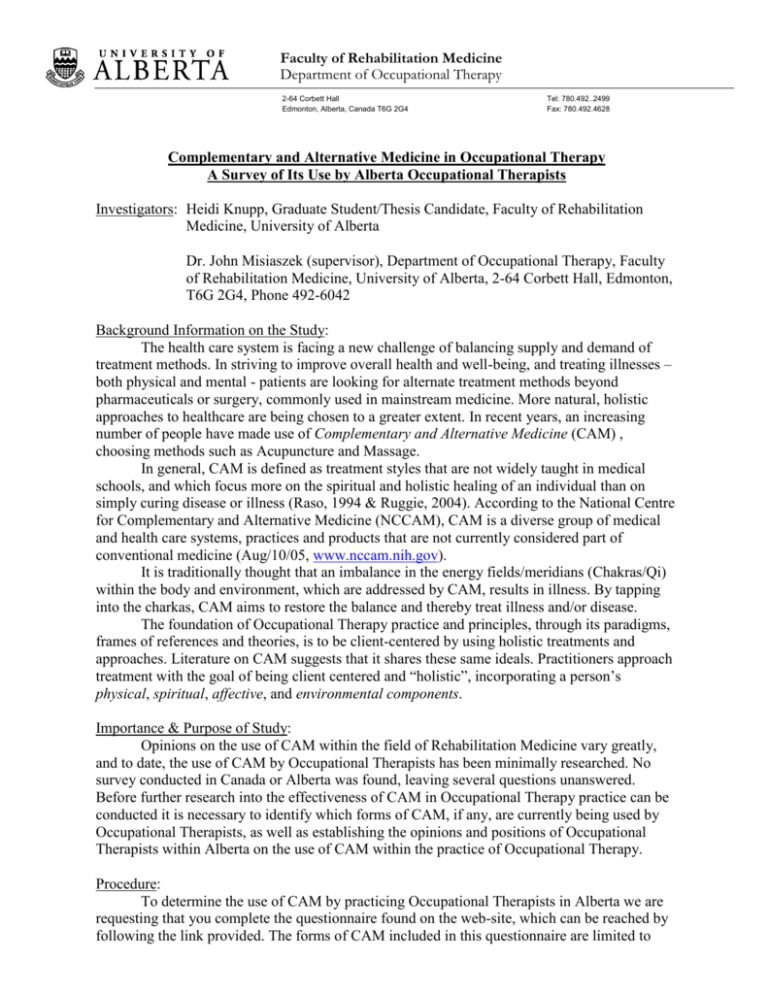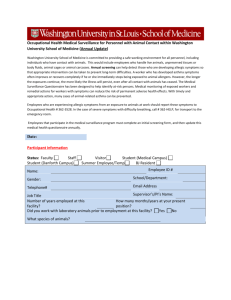Complementary and Alternative Medicine in Occupational Therapy
advertisement

Faculty of Rehabilitation Medicine Department of Occupational Therapy 2-64 Corbett Hall Edmonton, Alberta, Canada T6G 2G4 Tel: 780.492..2499 Fax: 780.492.4628 Complementary and Alternative Medicine in Occupational Therapy A Survey of Its Use by Alberta Occupational Therapists Investigators: Heidi Knupp, Graduate Student/Thesis Candidate, Faculty of Rehabilitation Medicine, University of Alberta Dr. John Misiaszek (supervisor), Department of Occupational Therapy, Faculty of Rehabilitation Medicine, University of Alberta, 2-64 Corbett Hall, Edmonton, T6G 2G4, Phone 492-6042 Background Information on the Study: The health care system is facing a new challenge of balancing supply and demand of treatment methods. In striving to improve overall health and well-being, and treating illnesses – both physical and mental - patients are looking for alternate treatment methods beyond pharmaceuticals or surgery, commonly used in mainstream medicine. More natural, holistic approaches to healthcare are being chosen to a greater extent. In recent years, an increasing number of people have made use of Complementary and Alternative Medicine (CAM) , choosing methods such as Acupuncture and Massage. In general, CAM is defined as treatment styles that are not widely taught in medical schools, and which focus more on the spiritual and holistic healing of an individual than on simply curing disease or illness (Raso, 1994 & Ruggie, 2004). According to the National Centre for Complementary and Alternative Medicine (NCCAM), CAM is a diverse group of medical and health care systems, practices and products that are not currently considered part of conventional medicine (Aug/10/05, www.nccam.nih.gov). It is traditionally thought that an imbalance in the energy fields/meridians (Chakras/Qi) within the body and environment, which are addressed by CAM, results in illness. By tapping into the charkas, CAM aims to restore the balance and thereby treat illness and/or disease. The foundation of Occupational Therapy practice and principles, through its paradigms, frames of references and theories, is to be client-centered by using holistic treatments and approaches. Literature on CAM suggests that it shares these same ideals. Practitioners approach treatment with the goal of being client centered and “holistic”, incorporating a person’s physical, spiritual, affective, and environmental components. Importance & Purpose of Study: Opinions on the use of CAM within the field of Rehabilitation Medicine vary greatly, and to date, the use of CAM by Occupational Therapists has been minimally researched. No survey conducted in Canada or Alberta was found, leaving several questions unanswered. Before further research into the effectiveness of CAM in Occupational Therapy practice can be conducted it is necessary to identify which forms of CAM, if any, are currently being used by Occupational Therapists, as well as establishing the opinions and positions of Occupational Therapists within Alberta on the use of CAM within the practice of Occupational Therapy. Procedure: To determine the use of CAM by practicing Occupational Therapists in Alberta we are requesting that you complete the questionnaire found on the web-site, which can be reached by following the link provided. The forms of CAM included in this questionnaire are limited to Page 2 those most likely to be used in practice. Each form of CAM contained in the questionnaire is briefly described. Responses need to be based on these definitions to ensure consistency and minimize ambiguity. Responses will be selected from a drop-down menu bar, except when opinions and/or comments are requested. Completion of the survey will take approximately 2030min of your time. You do not have to take part in this survey if you do not wish to. Confidentiality: All information provided will remain confidential. The demographic information provided is of general nature and will not allow the researcher to identify you. As the survey is completed on-line, please be advised that only IP addresses will be kept for security purposes. Only the primary researchers will have access to the IP addresses and any other identifying information. No identifying information of any sort will be attached to data collected in any published or presented information. Information provided will be kept for five years in a locked cabinet at the University of Alberta, following completion of the study. Digital data will be stored on a password protected medium. Anonymity: If you wish to remain completely anonymous, please follow the link provided, print off the questionnaire and return it in an envelope without identifying your return address. Options for Completion of Survey: You may return the survey using one of the following ways: a) complete it on the web-site by following the link provided. b) download it from the web-site, and fax or mail it to the address below Consent: By completing and returning the questionnaire you imply that you consent to participate in this study. As such, you infer: 1) 2) 3) 4) you understand that you have been asked to be in a research study. you have read the information provided in this correspondence. you understand the benefits and risks involved in taking part in this study. you have the opportunity to ask questions or discuss this study by contacting the researchers using the contact information provided. 5) you understand that you are free to refuse to participate, or to refuse to answer any questions you so choose. 6) you understand that your involvement and responses will remain confidential. 7) you understand who will have access to your records. PLEASE PRINT AND RETAIN A COPY OF THIS LETTER FOR YOUR RECORDS Page 3 If you wish to receive a paper version of the questionnaire by mail, please contact Heidi Knupp at the phone number or email provided and a copy will be sent to you. If you have any other questions about the study you can contact Heidi Knupp at the phone number or email address provided. If you have any concerns about any aspect of this study, please contact Dr. Paul Hagler, Associate Dean of Research, Faculty of Rehabilitation Medicine, at (780)492-9674. Heidi Knupp Department of Occupational Therapy 2-64 Corbett Hall University of Alberta Edmonton, AB T6G 2E1 Email: hknupp@ualberta.ca Phone: (780)492-6042 Fax: (780)492-4628 (OT dept. fax) Thank you very much in advance for your time and participation, your opinions and comments are invaluable to this study. Sincerely, Heidi Knupp, MScOT Candidate





